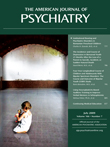Dr. Goldberg Replies
To the Editor: Dr. Liebowitz offers an interesting anecdotal observation about the potential importance of diurnal variation in bipolar depression and its possible relationship to mood stabilizer response. Unfortunately, the Systematic Treatment Enhancement Program for Bipolar Disorder (STEP-BD) study did not obtain data on this clinical characteristic during depressive episodes. Existing literature on the phenomenology of bipolar depression has not identified diurnal variation as a feature that is more common in bipolar than unipolar depression, in contrast to other constructs such as reversed vegetative signs (1) . However, some investigators have hypothesized that diurnal mood variation may reflect disruptions of circadian rhythms in healthy volunteers (2) , suggesting a possible role in cyclical or highly recurrent mood disorders.
Dr. Liebowitz also raises the hypothesis that short-acting antidepressant preparations may be less prone than longer-acting formulations to induce affective polarity switch. STEP-BD found no differences in treatment-emergent affective switch in bipolar depressed patients who underwent equipoise randomization to adjunctive bupropion sustained-release, paroxetine, or placebo in conjunction with mood stabilizers (3) . Lack of efficacy appears to be an overall greater risk than induction of mania for most depressed bipolar patients who receive adjunctive antidepressants. The STEP-BD study did not evaluate depression outcomes with highly noradrenergic antidepressants, such as venlafaxine, but their apparent higher risk for induction of mania relative to predominantly serotonergic or dopaminergic antidepressants (4) would seem to prompt caution if one chose to expose a bipolar patient to other noradrenergic agents, especially those not studied in bipolar disorder, such as atomoxetine.
1. Bowden CL: Strategies to reduce misdiagnosis of bipolar depression. Psychiatr Serv 2001; 52:51–55Google Scholar
2. Murray G: Diurnal mood variation in depression: A signal of disturbed circadian function? J Affect Disord 2007; 102:47–53Google Scholar
3. Sachs GS, Nierenberg AA, Calabrese JR, Marangell LB, Wisniewski SR, Gyulai L, Friedman ES, Bowden CL, Fossey MD, Ostacher MJ, Ketter TA, Patel J, Hauser P, Rapport D, Martinez JM, Allen MH, Miklowitz DJ, Otto MW, Dennehy EB, Thase ME: Effectiveness of adjunctive antidepressant treatment for bipolar depression. N Engl J Med 2007; 356:1711–1722Google Scholar
4. Post RM, Altshuler LL, Leverich GS, Frye MA, Nolen WA, Kupka RW, Suppes T, McElroy S, Keck PE, Denicoff KD, Grunze H, Walden J, Kitchen CM, Mintz J: Mood switch in bipolar depression: comparison of adjunctive venlafaxine, bupropion, and sertraline. Br J Psychiatry 2006; 189:124–131Google Scholar



